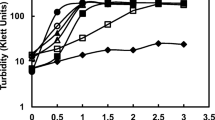Abstract
The foodborne pathogenStaphylococcus aureus is distinguished by its ability to grow within environments of extremely high osmolarity (e.g., foods with low water activity values). In the present study, we examined the accumulation of intracellular organic solutes withinS. aureus strain ATCC 12600 when cells were grown in a complex medium containing high concentrations of NaCl. Consistent with previous reports [Measures JC (1975) Nature 257:398–400; Koujima I, et al. (1978) Appl Environ Microbiol 35:467–470; and Anderson CB, Witter LD (1982) Appl Environ Microbiol 43:1501–1503], intracellular proline was found to accumulate to high concentrations. However, NMR spectroscopy of cell extracts revealed glycine betaine to be the predominant intracellular organic solute accumulated within cells grown at high osmolarity. In additional experiments, we examined the growth rate ofS. aureus in a defined medium of high osmolarity and found it to be stimulated significantly by the presence of either exogenous proline or glycine betaine. Highest growth rates were obtained when the defined medium was supplemented with glycine betaine.
Similar content being viewed by others

Literature Cited
Abe I, Tsujioka H, Wasa T (1988) Solvent extraction cleanup for pre-treatment in amino acid analysis by gas chromatography. J Chromatog 449:165–174
Anderson CB, Witter LD (1982) Glutamine and proline accumulation byStaphylococcus aureus with reduction in water activity. Appl Environ Microbiol 43:1501–1503
Bae J-H, Miller KJ (1990) Characterization of two proline transport systems inStaphylococcus aureus and their possible roles in osmotic adaptation. Abstracts of the Annual Meeting of the American Society for Microbiology 1990:283
Banwart GJ (1981) Basic food microbiology. New York: Van Nostrand Reinhold
Bergdoll MS (1989)Staphylococcus aureus. In: Doyle MP, (ed) Foodborne bacterial pathogens. New York: Marcel Dekker, pp 463–523
Booth IR, Cairney J, Sutherland L, Higgins CF (1988) Enteric bacteria and osmotic stress: an integrated homeostatic system. J Appl Bacteriol Symp Suppl Series No. 17, pp 35S–49S
Bradford MM (1976) A rapid and sensitive method for the quantitation of microgram quantities of protein utilizing the principle of protein-dye binding. Anal Biochem 72:248–254
Brown AD, Simpson JR (1972) Water relations of sugar-tolerant yeasts: the role of intracellular polyols. J Gen Microbiol 72:589–591
Christian JHB, Waltho JA (1961) The sodium and potassium content of non-halophilic bacteria in relation to salt tolerance. J Gen Microbiol 25:97–102
Christian JHB, Waltho JA (1962) Solute concentrations within cells of halophilic and non-halophilic bacteria. Biochim Biophys Acta 65:506–508
Christian JHB, Waltho JA (1964) The composition ofStaphylococcus aureus in relation to the water activity of the growth medium. J Gen Microbiol 35:205–218
Csonka LN (1989) Physiological and genetic responses of bacteria to osmotic stress. Microbiol Rev 53:121–147
Genigeorgis CA (1989) Present state of knowledge on staphylococcal intoxication. Int J Food Microbiol 9:327–360
Grothe S, Krogsrud RL, McClellan DJ, Milner JL, Wood JM (1986) Proline transport and osmotic stress response inEscherichia coli K-12. J Bacteriol 166:253–259
Hanson RS, Philiips JA (1981) Chemical composition. In: Gerhardt P, Murray RGE, Costilow RN, Nester EW, Wood WA, Krieg NR, Phillips GB (eds) Manual of methods for general bacteriology. Washington, DC: American Society for Microbiology, pp 328–364
Hocking AD (1988) Strategies for microbial growth at reduced water activities. Microbiol Sci 5:280–284
Hutkins RW, Ellefson WL, Kashket ER (1987) Betaine transport imparts osmotolerance on a strain ofLactobacillus acidophilus. Appl Environ Microbiol 53:2275–2281
Kashket ER, Blanchard AG, Metzger WC (1980) Proton motive force during growth ofStreptococcus lactis cells. J Bacteriol 143:128–134
Koujima I, Hayashi H, Tomochika K, Okabe A, Kanemasa Y (1978) Adaptational change in proline and water content ofStaphylococcus aureus after alteration of environmental salt concentration. Appl Environ Microbiol 35:467–470
Le Rudulier D, Valentine RC (1982) Genetic engineering in agriculture: osmoregulation. Trends Biochem Sci 7:431–433
Le Rudulier D, Strom AR, Dandkar AM, Smith LT, Valentine RC (1984) Molecular biology of osmoregulation. Science 224:1064–1068
Measures JC (1975) Role of amino acids in osmoregulation of non-halophilic bacteria. Nature 257:398–400
Minor TE, Marth EH (1976) Staphylococci and their significance in foods. New York: Elsevier Scientific Publishing
Pattee PA, Neveln DS (1975) Transformation analysis of three linkage groups inStaphylococcus aureus. J Bacteriol 124:201–211
Riemann H, Bryan FL (1979) Food-borne infections and intoxications. New York: Academic Press
Smith JL, Buchanan RL, Palumbo SA (1983) Effect of food environment on staphylococcal enterotoxin synthesis: a review. J Food Prot 46:545–555
Troller JA (1986) Water relations of foodborne bacterial pathogens—an updated review. J Food Prot 49:656–670
Witter LD, Anderson CB (1987) Osmoregulation by microorganisms at reduced water activity. In: Montville TJ (ed) Food microbiology, vol. 1. Boca Raton, Florida: CRC Press, pp 1–34
Author information
Authors and Affiliations
Rights and permissions
About this article
Cite this article
Miller, K.J., Zelt, S.C. & Bae, JH. Glycine betaine and proline are the principal compatible solutes ofStaphylococcus aureus . Current Microbiology 23, 131–137 (1991). https://doi.org/10.1007/BF02091971
Issue Date:
DOI: https://doi.org/10.1007/BF02091971



